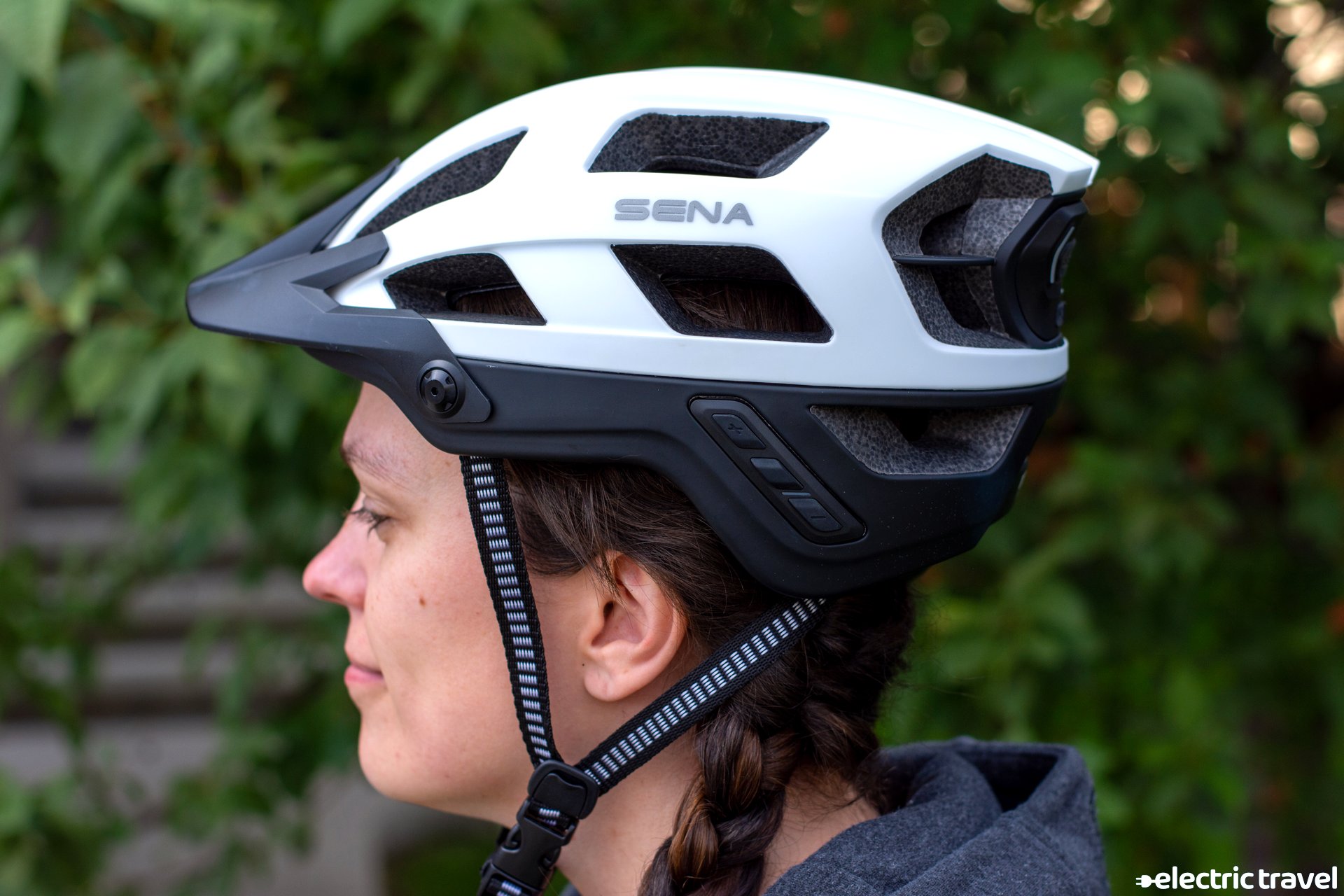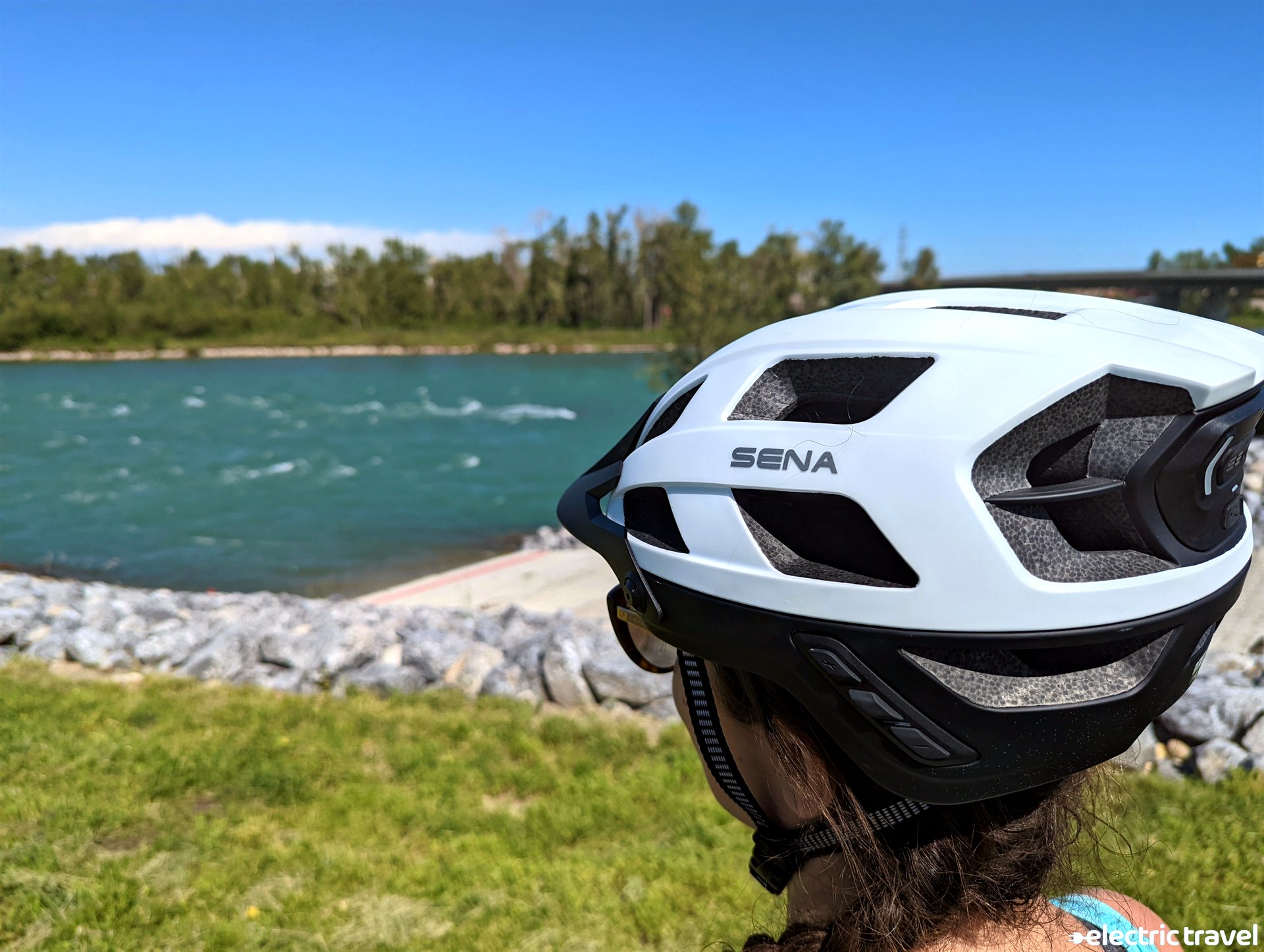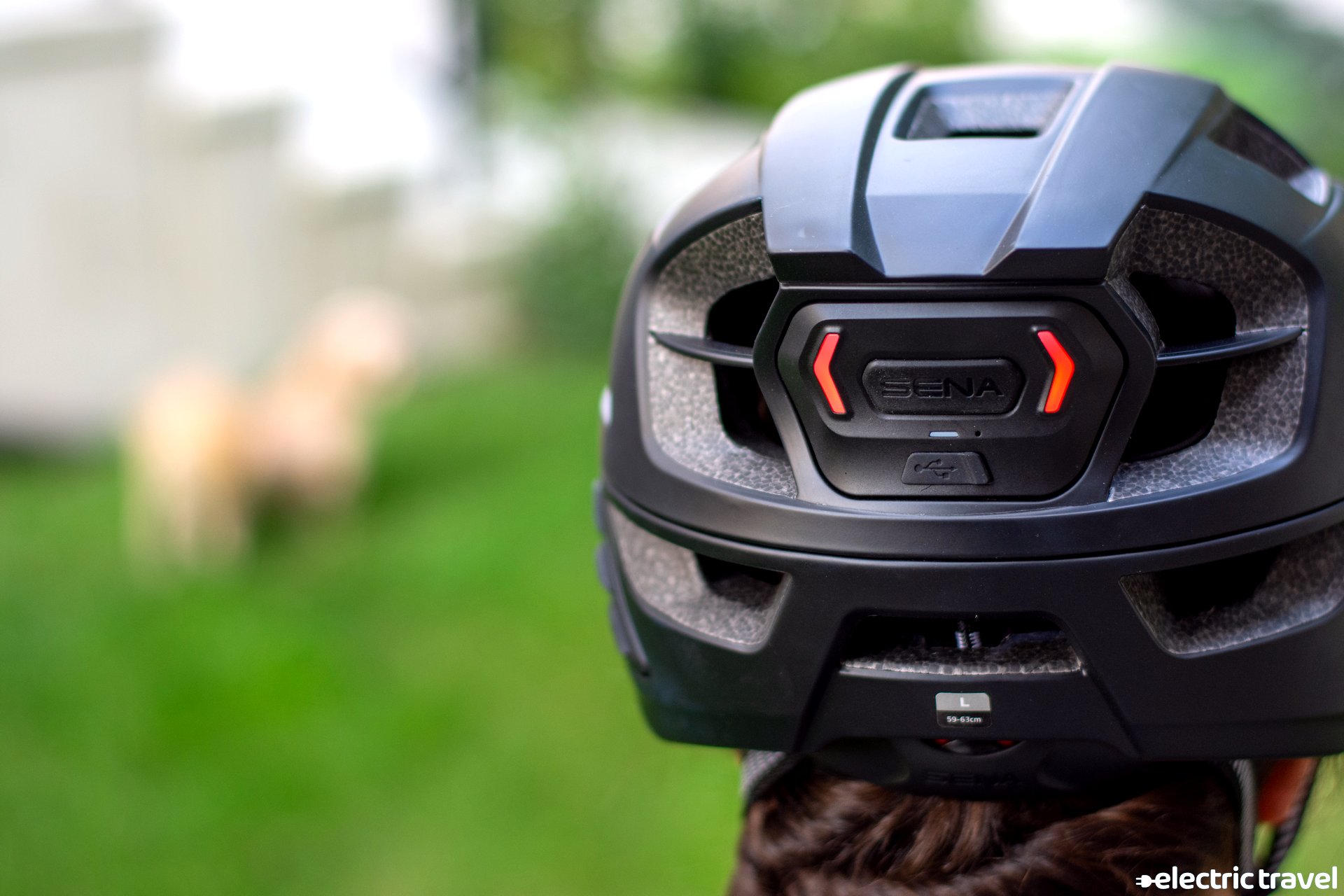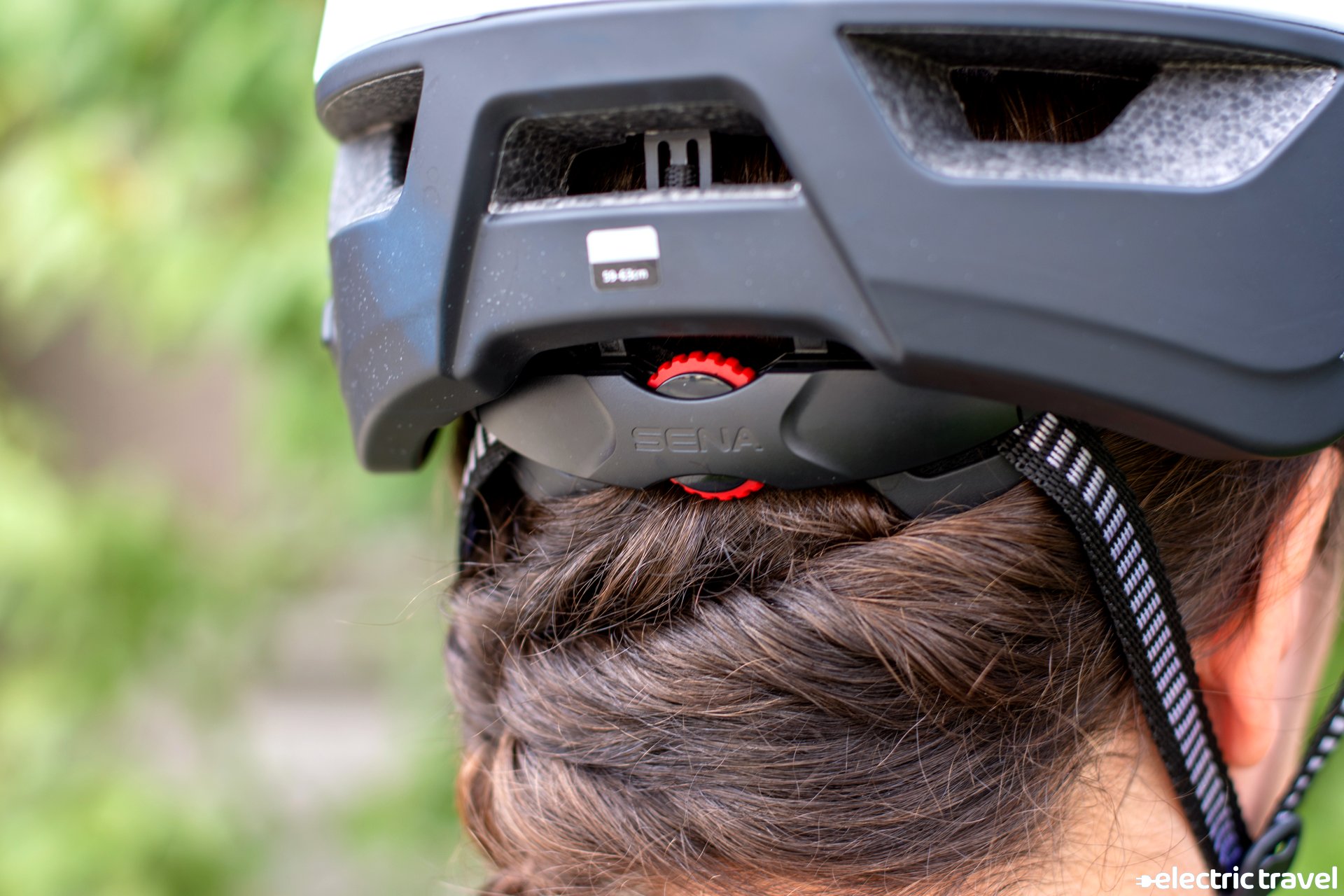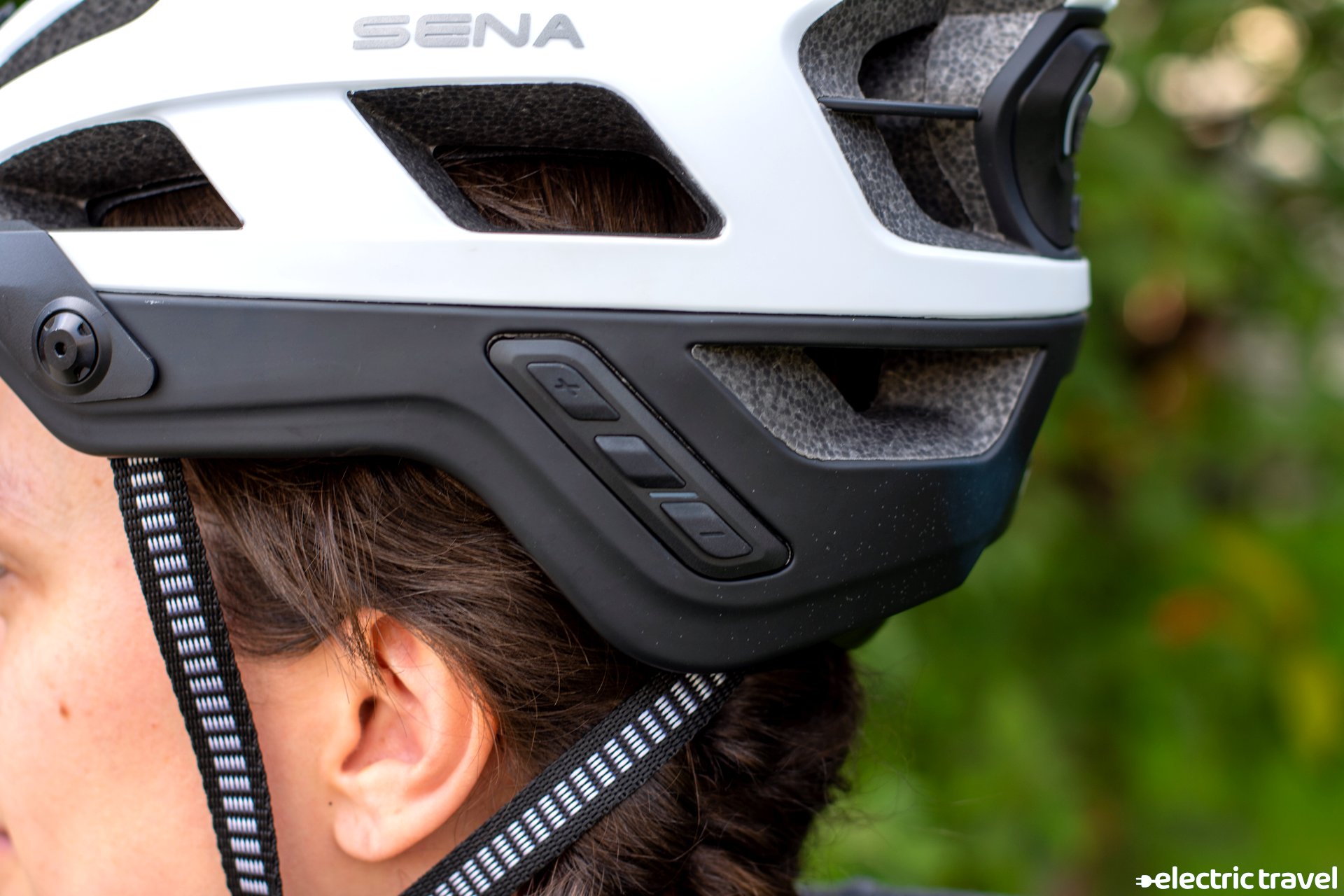Review Summary
- The Sena M1 is a solid helmet and easily a top contender in the bluetooth mountain bike helmet segment
- The Sena M1 weighs in at 430 g / 0.95 lbs and is comfortable to wear
- Adjusting helmet fit is easy thanks to the rear adjustment rotary dial and quick-snap fittings on the strap
- Sound quality is acceptable but lacks bass
- Battery life averages 15 hours/charge in real-world conditions
- You can connect via Bluetooth immediately, but to make use of intercom functionality you’ll need to install the Sena Utility app
- At $169 USD, the value proposition is quite good
Excellent Electronics & an Easy-to-Use App Combine to Make the M1 One Connected Lid
After yet another harsh Canadian winter, spring arrived in full force and I was ecstatic to get on the trails. Living in beautiful Calgary, Alberta, I’m never more than 90 minutes away from the Rocky Mountains and the nearby town of Banff; both offer a plethora of trails to ride, hills to climb, and drops to… drop.
If you’re a trail rider, Calgary might as well be nirvana. If you’re a downhill rider, Banff is most certainly on your “to ride” list.
In addition to nearby Banff and the mountains it is situated in, Calgary has an extensive pathway system throughout the city as well as an expansive park (Fish Creek Park) that bisects the city. Calgary has more than 1,000 km (600 miles) of bike paths and 96 km (~58 miles) of dedicated trails. This is all in addition to the plethora of trails in the surrounding countryside, foothills, and mountains.
With the M1 on my noggin, I traversed many of these paths and trialed many of these trails while using and abusing my 2021 Surface 604 Shred. I got fit, enjoyed my summer, and listened to my favorite tunes along the way. After nearly 800 km (~500 miles) of riding with the M1, I am ready to share my thoughts.
TLDR: this helmet is awesome.
About Our Reviews
When we perform a hands-on review, we are rigorous in our testing and we go deep. In addition to falling off of bikes in the name of science (see my 2021 Himiway Cruiser Step-Thru review), we are very specific in how our hands-on reviews operate.
Our sister site, webBikeWorld, has reviewed many Sena products, and we are not shy when we aren’t in love with one—our review of the Sena Momentum helmet is a great example. I’ve reviewed many helmets on wBW and am applying the same objectivity to my reviews here at Electric Travel.
Sena sent us these M1’s at no-cost for the purposes of this review. We are very clear with our brand/vendor relationships that providing a product in no way influences the review; a good review cannot be paid for. Also note that we participate in affiliate programs with Amazon (and others) and may receive a small commission if you purchase a product through our links. This commission comes at no cost to you and is how we fund our site and pay our team.
All that is to say, I’ve done my best to be as unbiased and objective as possible.
Initial Impressions of the Sena M1 eMTB Helmet
Sena supplied both matte white and a matte black colorways, and almost immediately we had a problem with the white helmet: the center button, which you need to turn on the helmet (among other functions), was stuck pressed in, meaning we were unable to turn on the helmet.
After a few minutes of finnicking with it, the middle button popped out of its depressed state and has remained a diligent performer ever since. I was worried that the fix would be temporary, but it has lasted several hundred kilometers of riding (and probably around 50 hours of use) without further issues.
The helmets themselves are unassuming, with no flashy graphics or extreme colors to draw the eye. Unassuming, that is, until the sun goes down and the rear tail light becomes much more visible. Arguably unnecessary during daylight, the tail light becomes a welcomed addition once night sets in.
Assuming the rear light is off, the M1 looks like any other mountain bike helmet from the right side, front, and rear (the left side has an LED that blinks blue when your phone is connected). The electronics are all black and are not visually obvious unless you know to look for them. Up close, the buttons are easier to see, but again, they aren’t a distraction.
Considering how obnoxious many “smart” products are, the M1 looking like any other helmet is welcome.
Sena M1 eMTB Helmet Key Specifications
- Weight: 430 grams / 0.95 lbs
- Battery life: Claimed 11-18 hours (~15 hours average observed)
- Charge time: 2.5 hours
- Materials: In-mold polycarbonate helmet shell with EPS liner
- Bluetooth: Bluetooth 4.1 codec
- Sound: Integrated speakers
- Mic: Noise canceling
- Intercom range: 900 meters (0.5 miles)
Sena M1 eMTB Helmet Build Quality
The M1 is built as good as my non-smart SMITHS helmets are, albeit with differences in priority and areas of focus. The polycarbonate shell does not have any mis-cuts, sharp edges, burrs, or other obvious visual deformities.
The “SENA” decals are both applied straight and in uniform positioning on either side of the helmet. There are a few areas where the edge between the shell and EPS liner aren’t totally smooth visually, but that is no different than any other helmet.
The M1 looks like any mountain bike helmet with a fixed visor, aside from a large black module at the rear, which contains the intercom unit, USB port, and LED lights.
Speaking of visor, it is attached via two proprietary connectors and some adhesive. It is removable, but not easily so, and I recommend you leave it where it is unless it’s a problem or in need of replacement.
The washable internal liner is removable, connecting to the interior using velcro. Don’t machine wash the liner, and definitely don’t wash the liner while it is still inside the helmet.
The strap’s quick-release buckles make it easy to adjust sizing, but I did have one of the clasps annoyingly fall off mid-adjustment. It snapped back into place and secured the strap, feeling no worse for wear and passing numerous “tug tests”.
Intercom & Speaker Integration
The microphone is positioned at the front of the helmet underneath the visor, with speakers integrated into the EPS liner directly above the ears and the intercom unit itself mounted in the rear.
On the left side of the helmet, just behind your ear, are the three buttons that operate the Intercom. At the rear of the helmet is the intercom itself, with the LED lights and button to activate them.
Unless you start picking away the EPS liner, you will never encounter a wire or electrical connection (aside from the USB port on the back). Everything is seamlessly integrated into the helmet.
Sena M1 eMTB Helmet Comfort & Fit
At 430 grams (0.95 lbs) for the medium size, and 465 grams (1.02 lbs) for the large size, the M1 is far from being lightweight. However, none of the helmets lighter than it have an integrated intercom, battery, mic, and speakers. With those additions factored in, the M1 is hardly a heavyweight.
The M1’s fit is also easy to adjust, with:
- Quick-release buckles on both straps to facilitate easy strap size adjustment
- A head size/shape adjustment at the rear that extends/contracts the liner size
- A rear rotary dial that quick tightens/relaxes the rear liner
Being so easy to use, it is no wonder that six different riders of varying experience levels (including a few with no riding experience at all) were able to effortlessly adjust the M1 to fit their head.
The weight and fit adjustability result in a helmet fit that is snug but not tight, easily adjusted to suit your tastes, and secured snugly against your head. No side to side wobble, no front to back rocking.
And critically, no pressure points anywhere along the head. Anywhere I felt pressure, I was able to adjust the helmet via the dial in the rear.
Unfortunately, I’ve developed degenerative disc disease in my low neck, and riding longer than a couple of hours routinely turns into a pain management exercise. The M1, at 465 grams (for the large version I’m wearing), is no exception to this. However, it isn’t meaningfully different from any other type of fatigue I experience in my neck while riding.
Sure, the M1 is a bit heavier than the average helmet, but not appreciably so, and it isn’t that noticeable in my opinion (and trust me when I say that I’d feel this long before most would).
Bluetooth Audio & Call Quality on the Sena M1 eMTB Helmet
The reason you paid $170 for this lid vs. half that price for a similar looking/feeling one is because the M1 comes jammed packed with all the connectivity you expect from a smart mountain bike helmet.
Let’s get the worst part of the M1’s electronics package out of the way: there is no—zero—bass to speak of. The audio is a tinny, treble-touting twang that lacks any mid or low tones. From a sound quality standpoint, any headphone will outperform the M1.
If you can get over that, there is a lot here to like:
- At full volume, other people will be able to hear the speakers from as far as 40 feet away
- At a volume I consider comfortable, that range decreases to a hair under 10 feet
- Any ambient noise will greatly reduce the sound travel from the M1 (remember, no bass to carry the sound)
- Though the audio lacks bass, the speakers are otherwise clear and easy to hear
- Call sound quality is pretty good, as the noise cancellation tech effectively mutes the mic until you’re talking
A downside is that callers sometimes could hear themselves via the M1’s mic, a problem that also plagues even the best motorcycle intercoms.
Using the Sena M1 eMTB Helmet
It takes less than a minute to connect to bluetooth and then connect intercoms together. Outside of the voice commands, which I found somewhat clunky (and do in basically every motorcycle intercom I’ve ever used, for the record), the M1 is simple enough to operate.
Connecting to & Pairing With the M1
The M1 may default into pairing mode the first time you turn it on (the LED indicator will flash blue/red to indicate this). If it doesn’t:
- Press and hold the top and middle buttons for 10 seconds
- Note: the M1 will say several prompts (“pairing headset”, “hello”) during this time; keep holding the buttons until it says “phone pairing”)
- If the helmet is already on, simply hold the center button until it says “phone pairing” (about 5 seconds)
- If required, the PIN is 0000
- The M1 will automatically connect to your phone every time you turn it on from there on out
Surprisingly, Sena does not have a video showing this, but this video from ERIK’s Bikes does an excellent job walking you through it:
Pairing Intercoms
If you and up to three friends want to ride connected, you can use the Sena Utility app to connect the intercoms together. The app provides a QR code that you can scan to connect (note: your helmet will already need to be paired/connected via Bluetooth for the Sena utility app to work).
This walkthrough video from Sena does a good job of explaining:
Controlling the M1
Using a three-button interface to control the intercom is confusing at first but quickly becomes a habit (and, crucially, muscle memory).
- Use the top/bottom (+ / -) buttons to adjust the volume up or down
- To answer an incoming call, press the center button; hold the center button for 2 seconds to ignore the call
- Press the center button for 3 seconds to activate voice commands (use the Sena utility app to further customize this)
- Press the rear “SENA” button to turn on the light; press the button again to turn on the night/day flash functions
- To change to the next song, hold the top button for 1 second; press the button button for 1 second to restart the song, or press it again to go to the previous song
A full guide to all commands is found in the Sena Utility app (as well as firmware updates).
The Sena M1 vs. the M1 EVO
The M1 is the “base” model of the family, with the M1 EVO being the premium version. Safety wise, they’re the same: the actual helmet is unchanged between the two. The differences lie in the electronics and intercom capability.
The key differences between the M1 and M1 EVO are:
- The M1 intercom works via Bluetooth, whereas the M1 EVO uses Sena’s Mesh technology (for more on this, see wBW’s Sena +Mesh Adapter review)
- The M1 supports four connected intercom devices in a network vs. the huge number that the M1 EVO can connect (it’s not unlimited, but it’s close)
- The M1 has a 800 meter (0.5 mile) intercom range, whereas the M1 EVO’s Mesh technology can provide a range of up to 4 km (2.5 miles) as long as each rider is within 800 meters (0.5 miles) of each other (hence, a “mesh” network)
- The M1 Evo’s Mesh network has up to 9 channels available, empowering users to have private conversations outside of the broader group
- The M1 MSRP is $169 vs. the M1 EVO’s MSRP of $199.
Should you buy the M1 Evo over the M1? Only if you intend to ride in large groups of other mesh-network compatible devices. Otherwise, I’d save the $30 premium and purchase the M1.
The Sena M1 is Arguably One of the Best Bluetooth Mountain Bike Helmets Available Today
A quick search on Amazon will show numerous bluetooth-enabled helmets at lower price points than the M1, but all of them come from no-name Chinese brands that are of dubious (and untested) quality.
The M1 is a good helmet overall, even when ignoring the integrated intercom and electronics, and it’s frankly a great helmet when you bring those components back into consideration.
It’s comfortable to wear, unassuming enough so as to avoid making you an obvious focal point while wearing it, and provides the easy connectivity that riders are looking for when shopping for bluetooth helmets.
Recommended.
Key Specs:
- Manufacturer: Sena
- Price (when tested): $169.00
- Colors: Matte Black (tested), Matte Grey, Matte White
- Sizes: M, L
Key Features:
- Bluetooth 4.1
- Four-way HD Intercom
- Intercom Range: 900m / 0.5mi
- Advanced noise control
- Tail-light
- Quick-charging
- Built-in speakers & mic
- High-grade polymer plastic outer shell



